A Private Tour today for a visitor from India, so we went out looking for all the commoner species, as well as some of the more unusual ones. It was bright in the morning, even sunny at times, before clouding over a bit more in the afternoon, but thankfully it stayed dry all day.
The plan was to spend part of the day at Titchwell, but on our way there we turned inland to look for some farmland species first. We stopped at the start of a footpath, lined with overgrown hedges and brambles. As we got out of the car, we flushed a covey of Red-legged Partridges from the edge of the field. A Common Buzzard was calling and we looked over the fields to see one circling up out of the trees in the distance.
As we walked along the footpath, we could hear a Common Whitethroat and it flicked away ahead of us a couple of times before diving back into cover. A Yellowhammer was perched in the top of the hedge, but silhouetted against the sky and it dropped down out of view as we approached. Thankfully when we returned to the car, a smart yellow-headed male Yellowhammer had appeared in the top of the hedge right by the road. A Reed Bunting sat up nicely here for us too.
A little further along the road, a Eurasian Curlew flew past us as we drove along. We were just talking about how you can find large flocks feeding in the fields here when we passed the next hedge and found about twenty Curlew in a stubble field. Some smaller birds were running around just beyond them, very hard to see at first in the tall stubble. We stopped and wound down the windows for a better look and confirmed they were Eurasian Golden Plover. Some were still sporting the remains to their black summer underparts, to a greater or lesser extent.
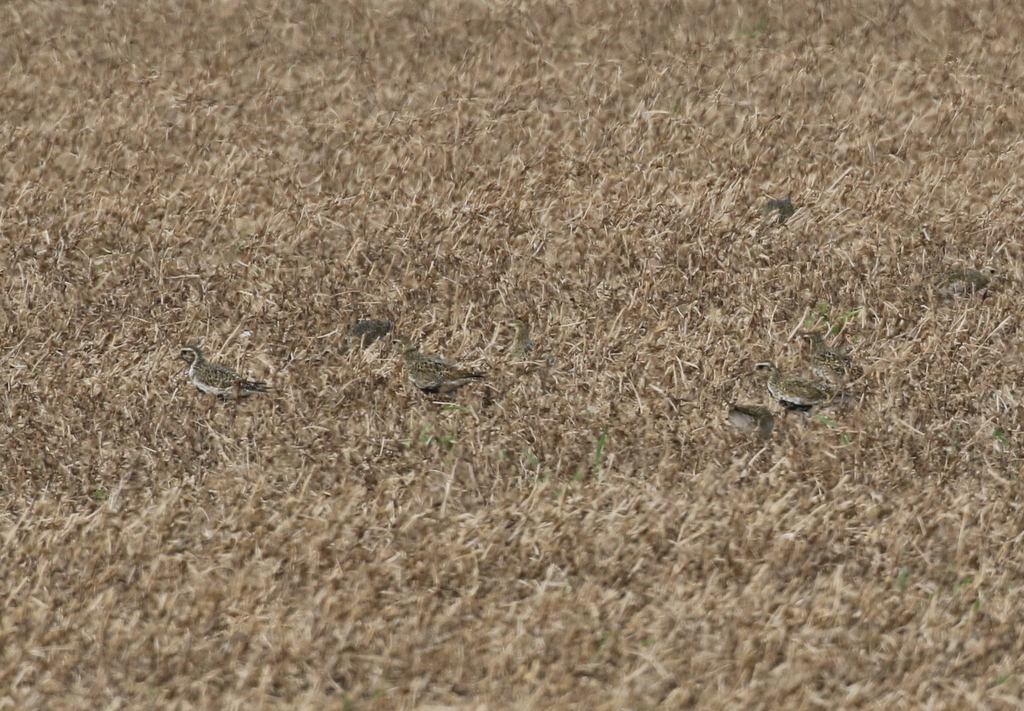 Golden Plovers – very well camouflaged in the stubble
Golden Plovers – very well camouflaged in the stubble
Carrying on towards Choseley, another Common Buzzard took off from a telegraph post by the road and glided away effortlessly ahead of us, while we stopped to look through a large flock of Black-headed Gulls and Herring Gulls. There were several (Northern) Lapwing in the field too. A little further on and a family of Grey Partridge hopped out of the grassy verge and ran along the road ahead of us. Despite being only half grown, the youngsters had no problem flying over the hedge eventually.
A weedy strip along the edge of a field held a nice flock of finches, which flew up and landed on the wires so we could look through them. They were mostly Linnets, lots of brown, streaky females and juveniles, but with a few males still sporting their red breasts from the summer. There were several Goldfinches and a couple of Greenfinches with them too. Up at the drying barns there was quite a bit of disturbance – tractors, combine harvester and birdwatchers! – so we didn’t linger here and made our way on, down to Titchwell. Approaching the reserve, a few Common Swifts were hawking for insects over the fields beside the road.
As we got out of the car, we could hear Long-tailed Tits calling in the trees by the car park. We walked over for a closer look and found a mixed flock, with Blue Tits and Great Tits and a couple of Chiffchaffs in with them too. The first cars were starting to use the overflow car park, so it was not as quiet as it might have been, but we did still manage to see a couple of Blackcaps as they flew out of the brambles where they had been feeding. The Wood Pigeons were showing well around the car park as usual and were duly admired today – they are much harder to see in India apparently! A Great Spotted Woodpecker flew over calling.
 Long-tailed Tit – a mixed flock was feeding in the car park
Long-tailed Tit – a mixed flock was feeding in the car park
The feeders by the visitor centre produced a few more common birds for the day’s list – a male Chaffinch hopped around under the bird table and a pair of Dunnocks few under the feeders. The resident Robins here were unusually reticent to come and perform today, although we did see one in the trees (they are usually hopping around under the picnic tables!). A Grey Squirrel on the feeders the other side of the visitor centre was also a source of interest.
As we walked out onto the reserve, a Wall butterfly was basking in the sunshine on one of the signs on the sea wall. We heard a Bearded Reedling (aka Bearded Tit!) calling from the reeds by the Thornham grazing marsh ‘pool’, but despite waiting here for a couple of minutes, it didn’t show itself. A Marsh Harrier flapped up out of the reeds at the back before dropping back down and a Little Egret flew up from the other side of the reeds at the front and disappeared over the path behind us.
 Wall – basking on one of the signs on the sea wall
Wall – basking on one of the signs on the sea wall
Other than a couple of Little Grebes, there were just a few Mallard on the reedbed pool, so we continued on towards Island Hide. Just before we got there, we stopped to listen to more Bearded Reedlings calling. Unfortunately one flew up out of the reeds just as we were looking in different directions and dropped in again too quickly for us both to get to see it. We decided we might have a better chance of seeing one on the edge of the reeds from the hide, so we continued on to there.
A few Common Teal were feeding on the mud right in front of the hide. Numbers are gradually increasing now, as they return here for the winter. Ducks in general are not looking their best at the moment, with all the drakes in drab eclipse plumage. The adult Shelduck have all left the UK and gone over to the Wadden See to moult, leaving behind all the duller juveniles, one of which was also dabbling in the mud by the hide.
 Shelduck – a juvenile feeding on the mud in front of the hide
Shelduck – a juvenile feeding on the mud in front of the hide
There were a few waders close to the hide too. At first, there were several Ruff here, the males already in winter plumage, having quickly lost their breeding plumage on their return. A Lapwing was a little further back on the edge of the mud too. We stopped a while to get some photographs of the various birds here.
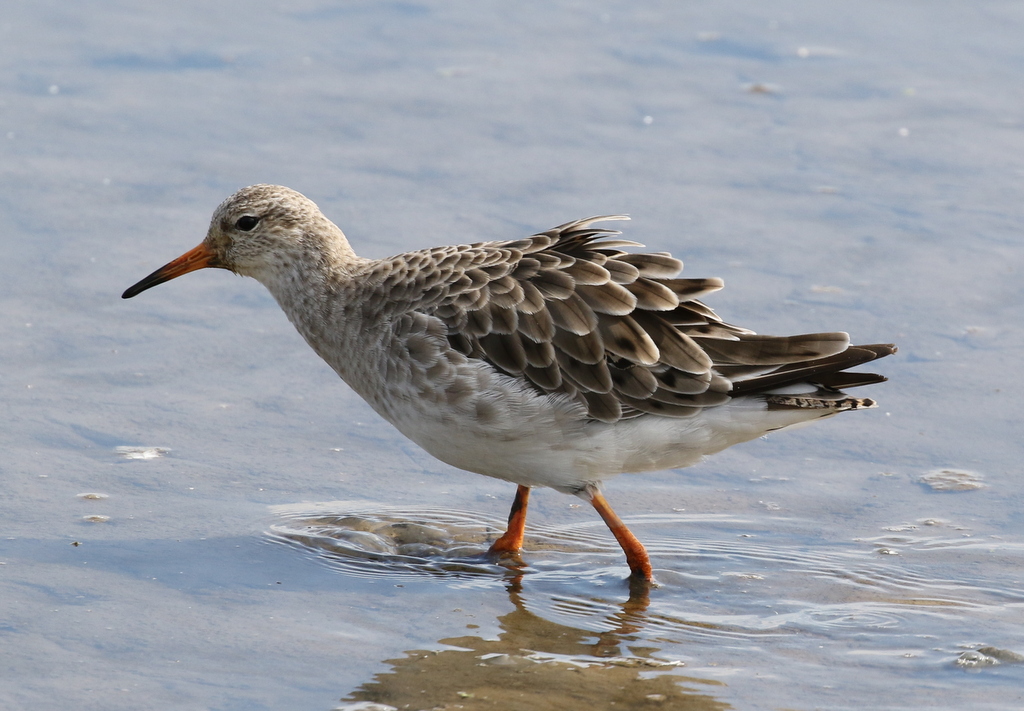 Ruff – a winter plumage male in front of the hide
Ruff – a winter plumage male in front of the hide
There are usually a few Avocets in front of the hide here and this is generally a good place to get photographs of them. At first today they were all much further over, but eventually our patience was rewarded when one came in and started feeding right in front of us, sweeping its bill from side to side across the surface of the wet mud.
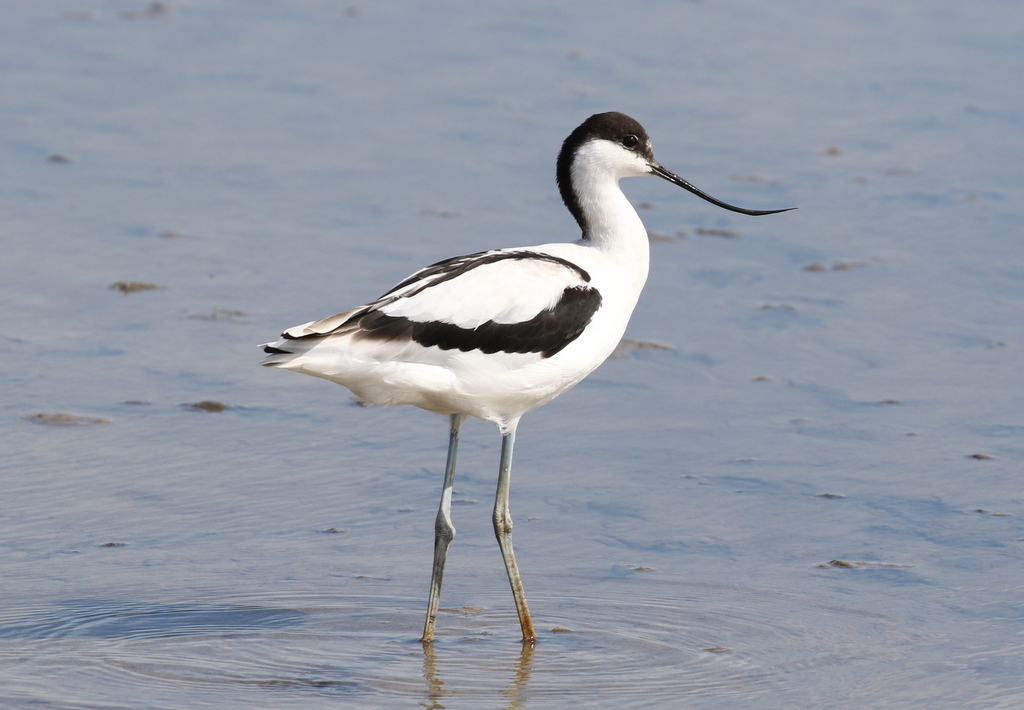 Avocet – one eventually performed for us in front of the hide
Avocet – one eventually performed for us in front of the hide
There were other waders here, further out on the freshmarsh. Through the scope, we could see a good number of Black-tailed Godwits. A little group of Dunlin were feeding on the exposed mud along the edge of the reedbed, mostly streaky-bellied juveniles but a single adult was still sporting a solid black belly patch.
Four Spoonbills over the back of the freshmarsh were all asleep, but we eventually found a Bearded Reedling on the edge of the reeds, working its way along just above the mud, weaving in and out. We had a good view of it in the scope.
After our very productive photography session in Island Hide, we made our way round to Parrinder Hide next. We quickly located the two Common Snipe which we had been told were feeding by the fence on the edge of Avocet Island. A couple of the Spoonbills had woken up now, so we got a look at them through the scope before they went back to sleep.
A Meadow Pipit dropped in to bathe on the edge of the water just along from the hide. A careful scan through the Pied Wagtails feeding out on the islands produced a couple of Yellow Wagtails in with them.
The Volunteer Marsh looked quiet at first, but as we walked out towards the beach, we could see quite a few waders feeding along the banks of the channel at the far end. There were several Common Redshanks and Black-tailed Godwits and half hidden down in the channel we managed to find a single Grey Plover, well camouflaged with its back to us against a background of grey mud. It was still mostly in summer plumage and, when it turned, we could see its black face.
Out at the beach, the tide was out. We walked down to the mussel beds to look through the waders. As well as lots of very noisy Oystercatchers, we could see quite a few Bar-tailed Godwits, with a couple of them still in bright rusty summer plumage. There were several Curlews and (Ruddy) Turnstones too. A juvenile Spoonbill out here on the mussel beds looked distinctly out of place!
Scanning along the beach, we found a couple of Sanderling running around on the sand in amongst the gulls, which included a few Great Black-backed Gulls for the day. In the distance, a line of (Great) Cormorants were drying their wings out at Thornham Point. A lone Fulmar circled overhead on stiff wings and made its way west along the shoreline, before a couple of distant Sandwich Terns flew past offshore and two adult Gannets flew back the other way a little bit closer in.
 Turnstone – feeding along the high tide line
Turnstone – feeding along the high tide line
At the top of the beach, we stopped to watch a couple of Turnstones feeding along the high tide line. They were not turning stones today, but pulling and shaking at the dry seaweed to try to dislodge any invertebrates. A Whimbrel called from somewhere out to sea, but then went quiet.
We stopped briefly to talk to a couple of local birders scanning the sea and they kindly pointed us in the direction of a Common Scoter out on the water. It drifted across and was joined by a second. A couple of Great Crested Grebes were out on the sea too.
 Black-tailed Godwit – a bright juvenile of the islandica subspecies
Black-tailed Godwit – a bright juvenile of the islandica subspecies
It was time for lunch now so we made our way quickly back. As we got to the freshmarsh, we could hear a Greenshank calling but didn’t see where it landed. A couple of juvenile Black-tailed Godwits were more obliging, feeding just below us along the edge of the reeds. Their bright rusty plumage confirmed they were of the islandica subspecies, which means they had just been born and raised in Iceland over the summer.
The Spoonbills commute in and out from the saltmarsh to feed and which we were walking back a couple of them flew back in, straight past us standing on the bank, giving us much closer views.
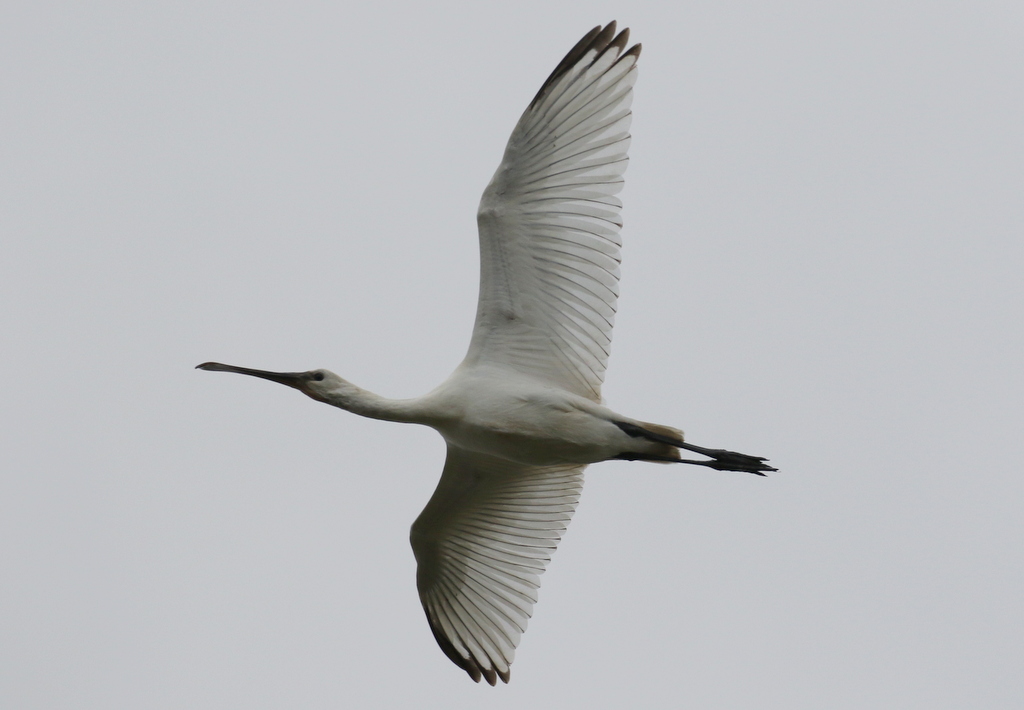 Spoonbill – flying back in from feeding out on the saltmarsh
Spoonbill – flying back in from feeding out on the saltmarsh
On the walk back, a Cetti’s Warbler sang from the reeds briefly as we walked back but remained typically well hidden down in the vegetation. We heard a Common Sandpiper calling from the reedbed pool, but it remained out of sight, probably feeding around the muddy edges behind the reeds.
Then it was back for lunch in the picnic area, where one of the local Robins was a little more obliging than earlier in the day. A couple of Migrant Hawker dragonflies were hawking around the willows here too and a single Common Darter stopped to bask on one of the benches.
After lunch, a couple of Bullfinch were calling in the trees by the car park but went quiet before we got a chance to track them down. A quick visit to use the facilities revealed a nice selection of moths and other insects on the walls in the toilet block. They are attracted by the lights which are left on here overnight. A quick look at the moths revealed a Light Emerald, a Snout and a couple of Brimstone, accompanied by a Speckled Bush-cricket!
 Light Emerald moth – on the wall in the toilet block
Light Emerald moth – on the wall in the toilet block
For the first part of the afternoon, we wanted to explore the rest of Titchwell, Fen Trail and round to the Autumn Trail which is open at this time of year. A Jay was in the sallows along Fen Trail, hopping around above our heads, but otherwise the trees were rather quiet.
The surprise find along here was a Willow Emerald damselfly (also known as Western Willow Spreadwing) which was perched on the vegetation by the path. This species is a very recent colonist in the UK, from about 2007 in Norfolk, and has only started to occur in North Norfolk with any regularity in the last few years. Apparently there are still only a very few records from Titchwell!
 Willow Emerald damselfly – still a rare species at Titchwell
Willow Emerald damselfly – still a rare species at Titchwell
The water levels on Patsy’s Reedbed are high now, so there were quite a few ducks out on the pool. They were mostly Gadwall and Mallard, but we also managed to find a single Tufted Duck and a couple of Common Pochard to add to the day’s tally. A careful scan around the edge of the reeds produced a Reed Warbler feeding low down at the water’s edge, before it or another flew up and started flycatching in the sallows in front of the viewing screen.
Stopping to look at a flock of finches in the dead trees by the paddocks, we noticed a couple of smaller birds chasing each other in and out of the hedge, two Lesser Whitethroats. Eventually they gave up chasing each other and one flew in and landed in the hedge much closer to us, before feeding on the blackberries, where we could get a good look at it.
Round at the end of Autumn Trail, we stopped to look out over the back of the freshmarsh. A single winter plumage Spotted Redshank was asleep over towards the Avocet Island fence, but there was no sign now of the Greenshank which had apparently been here earlier.
A careful scan along the edge of the reeds revealed a Water Rail picking its way across the mud, in and out of the vegetation. There were a couple of volunteers here who had just finished erecting some fence posts nearby and the Water Rail disappeared back into the reeds when they came over to try to see it. As soon as they left, it walked out into a gap in the reeds and stood preening for several minutes, so we could get a good look at it in the scope. Typical!
As we walked up to here, we had heard the distinctive ‘pinging’ call of Bearded Reedlings and we had had a quick glimpse of one as it flew up from the edge of the cut reed. When we heard more pinging calls just across the mud in front of us, we up to see two juvenile Bearded Reedlings perched in the top of the reeds just above the Water Rail. We didn’t know where to look! We had a great view of them through the scope.
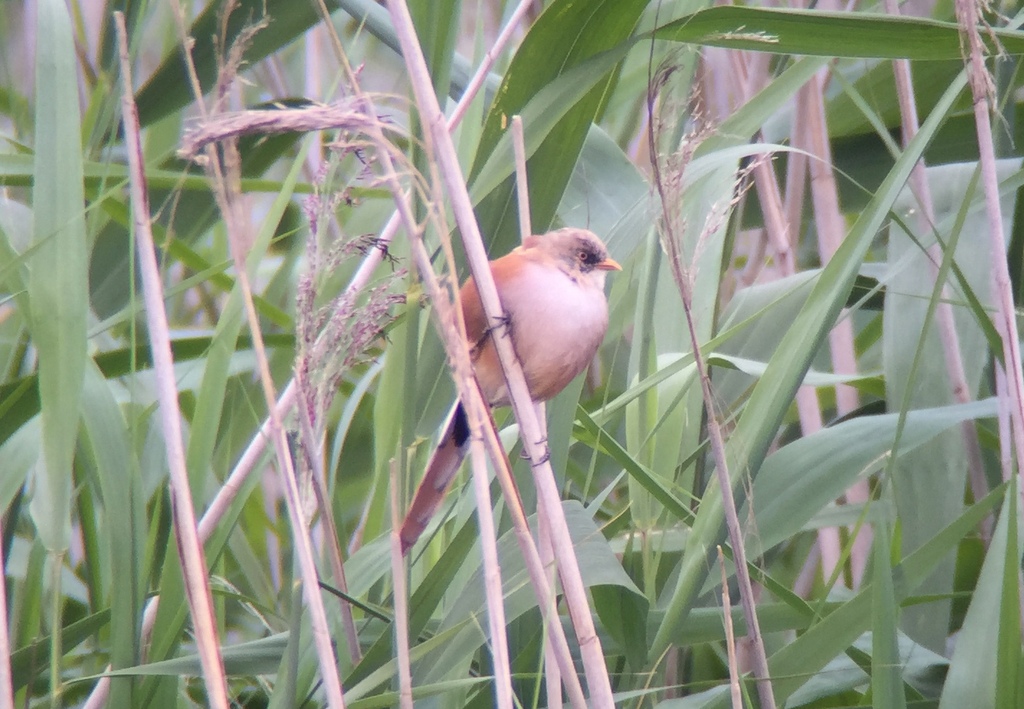 Bearded Reedling / Tit – perched up nicely in the reeds at the end of Autumn Trail
Bearded Reedling / Tit – perched up nicely in the reeds at the end of Autumn Trail
As we started to walk back, many of the Black-headed Gulls which had earlier been loafing on the freshmarsh were now hawking for insects, probably flying ants, over the reedbed. A smaller, dark shape dropped sharply out of the throng, a Hobby. It set off briefly after a Starling which was flying below, before giving up and flying back up into the mass of gulls where it also appeared to be catching insects.
We had planned to spend the rest of the afternoon at Holkham, so we made our way back to the car and headed back east along the coast road. When we got to Lady Anne’s Drive we discovered that it was closed. ‘For operational reasons’ was the only explanation we could get from the parking attendant at the gate, despite the fact that there were still plenty of cars parked along the drive and the horse box and taxi in front of us were allowed in. They seem to be making an annoying habit of closing Lady Anne’s Drive at the moment!
A quick change of plan, and we made our way over to Wells beach car park instead, in the hope of picking up some woodland birds in the pines. As we had hoped, at this time of day the car parks were already emptying and there were plenty of spaces. We walked in through the gates and past the boating lake, along the main path on the edge of the trees. It was fairly quiet at first here. The highlight was a juvenile Marsh Harrier hunting out over Quarles marsh. It was wearing a couple of bright green wing tags but was unfortunately too far off to read the codes.
We headed for the drinking pool in the hope we might be able to intersect with a tit flock and were almost there when we ran into a large flock of birds coming in the opposite direction. We heard the Long-tailed Tits coming first and quickly found ourselves surrounded by birds. There were lots of Coal Tits in the tops of the pines, so we got a good look at those first. There were good numbers of Blue Tits and Great Tits with them too.
When we heard a Treecreeper calling, we looked across to see one climbing up the trunk of a tree. It disappeared back onto another tree, before reappearing chased by a second Treecreeper and the two of them followed each other up another trunk. Then a Great Spotted Woodpecker appeared in the top of the pines above them. As the tit flock moved on back through the trees alongside the path, we followed them. As they crossed the path, we found a few Goldcrests in the flock too and with patience we got good views of them lower down in the trees.
When the flock moved further into the trees, we left them to it and walked on to the drinking pool. Perhaps not surprisingly, with all the birds heading in the opposite direction, it was quiet here now, so we went back and quickly picked up the tit flock again. It seemed to be heading out into a more open area now, so we followed. Some of the birds flew out into the scattered bushes in the open, while others were reluctant to follow, remaining in the birches. The flock seemed to stop here for a few minutes, unsure which way it was going, which gave us another chance to look through it.
A small lemon-yellow breasted bird appeared in the top of the birches with the tits, a juvenile Willow Warbler, perhaps bred locally or possibly a migrant on its way south already. Unfortunately, it was very hard to get onto in the birches, flitting around constantly and only showing itself briefly a few times. As the flock finally made up its collective mind and then turned to head back into the trees, we picked up three Blackcaps which flew out of the bushes behind the rest of the birds.
It was time to make our way back to the car now, but at least our mission here had been successful in adding some woodland birds to the list. A Jay flew out and hopped around on the path in front of us on the way,
 Jay – flew out onto the path on our walk back
Jay – flew out onto the path on our walk back
It had been a very successful day with an excellent variety of birds seen, and several different butterflies, moths and dragonflies too. A great introduction to birding in the UK!
















